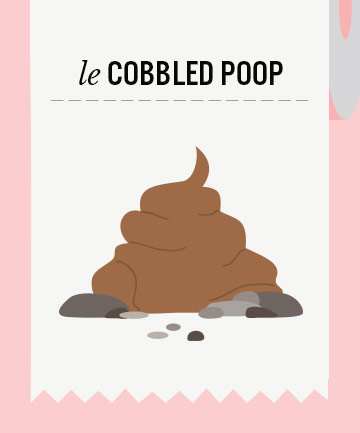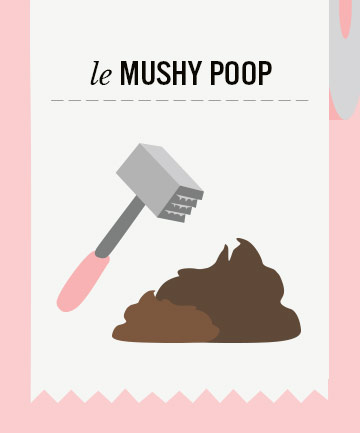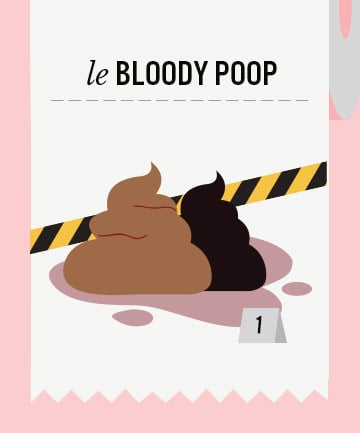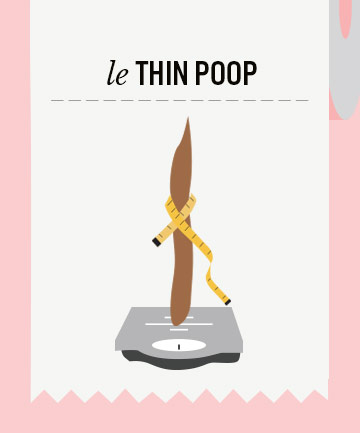What It Looks Like: Your retirement plan, that important work presentation, your poop — these are all things that you don't want cobbled together. But a cobbled poop isn't something that is hastily put together (more on that in a bit), but rather a stool with a lumpy, uneven surface that resembles cobbles — and in no way evokes the charm of the cobblestone streets you roamed during your semester abroad.
What It Means: According to Sheth, cobbled poop usually gets its uneven surface because there are areas of the stool that have become hard and firm due to getting dried out from sitting in the colon for too long. Since, as Sheth explains, the colon's primary function is to absorb water, if your stool hangs out in the colon for too long, it'll leave as a pretty parched poop. This can occur when people have slow colons — which can be caused by anything from lifestyle choices (think an overly sedentary lifestyle) to medications to hormonal changes during pregnancy.
Additionally, bumpy bowel movements with irregular surfaces can be a sign that you have mild constipation and that you're not getting enough fiber and water. Sensing a pattern here?
What It Means: According to Sheth, cobbled poop usually gets its uneven surface because there are areas of the stool that have become hard and firm due to getting dried out from sitting in the colon for too long. Since, as Sheth explains, the colon's primary function is to absorb water, if your stool hangs out in the colon for too long, it'll leave as a pretty parched poop. This can occur when people have slow colons — which can be caused by anything from lifestyle choices (think an overly sedentary lifestyle) to medications to hormonal changes during pregnancy.
Additionally, bumpy bowel movements with irregular surfaces can be a sign that you have mild constipation and that you're not getting enough fiber and water. Sensing a pattern here?
What It Looks Like: Not quite diarrhea, not quite a fully formed poop, this bowel movement middleman is soft, loose and totally non-cohesive. People who eliminate waste in this manner will find that clean-up is, well, a pretty sh*itty process. They may also have multiple mushy bowel movements per day that may have them throwing their hands up and thinking, 'Poop, can you do me a solid? Like, literally?'
What It Means: According to Sheth, you can see this type of stool in people with irritable bowel syndrome, lactose intolerance or celiac disease. "If you're eating something that you're body's not able to process, the end result, for the most part, is that you're going to have more frequent and looser bowel movements," says Sheth. He's quick to point out that these are broad generalizations and that if your have a sudden onset of mushy poops that get worse and worse, it's best to consult a doctor. Consider it a well-formed plan of attack to counter your poorly formed poop.
What It Means: According to Sheth, you can see this type of stool in people with irritable bowel syndrome, lactose intolerance or celiac disease. "If you're eating something that you're body's not able to process, the end result, for the most part, is that you're going to have more frequent and looser bowel movements," says Sheth. He's quick to point out that these are broad generalizations and that if your have a sudden onset of mushy poops that get worse and worse, it's best to consult a doctor. Consider it a well-formed plan of attack to counter your poorly formed poop.
What It Looks Like: There are two ways that blood can show up in poop; one is more easily recognizable than the other, appearing — as you might expect — in the form of familiar red blood, while the other is a little more insidious, presenting itself as jet-black stool.
What It Means: "If you see red blood in your stool or very dark stool, then that's something that should prompt some action — most likely you should discuss it with your doctor," says Sheth. "It can indicate a host of things — anything from an ulcer bleeding to colon polyps to something as benign as hemorrhoids."
If you have jet black stool, that's a sign of blood that's originated from higher up, like the stomach. "Blood changes color as it goes downstream," Sheth explains. If you had an ulcer, [blood] would show up black." Alternatively, the redder the blood presents itself, the more likely it is that it originated further downstream. If the bleeding is associated with constipation or hard stools, Sheth says the likely culprit is hemorrhoids but cautions individuals to get checked out if the bleeding is new and represents a change in their norm.
What It Means: "If you see red blood in your stool or very dark stool, then that's something that should prompt some action — most likely you should discuss it with your doctor," says Sheth. "It can indicate a host of things — anything from an ulcer bleeding to colon polyps to something as benign as hemorrhoids."
If you have jet black stool, that's a sign of blood that's originated from higher up, like the stomach. "Blood changes color as it goes downstream," Sheth explains. If you had an ulcer, [blood] would show up black." Alternatively, the redder the blood presents itself, the more likely it is that it originated further downstream. If the bleeding is associated with constipation or hard stools, Sheth says the likely culprit is hemorrhoids but cautions individuals to get checked out if the bleeding is new and represents a change in their norm.
What It Looks Like: This poop is thin-and-narrow, which might be cool if your poop needed to, say, prep its bikini bod, but it just looks plain weird when you're used to seeing something a little more substantial in your toilet bowl.
What It Means: According to Sheth, the usual culprit behind pencil-thin stools is — you guessed it — a lack of dietary fiber. "Because you're constipated, you end up straining and instead of having the anal sphincter muscle open up and relax — which is what normally happens with a bowel movement — you're actually tensing up and clenching so much that the opening through which the stool comes is narrowed and that's going to narrow the stool."
If however, your find your stool is getting progressively narrower and smaller, you may want to consult your doctor, as it may be a sign that rectal cancer is causing the opening to narrow.
What It Means: According to Sheth, the usual culprit behind pencil-thin stools is — you guessed it — a lack of dietary fiber. "Because you're constipated, you end up straining and instead of having the anal sphincter muscle open up and relax — which is what normally happens with a bowel movement — you're actually tensing up and clenching so much that the opening through which the stool comes is narrowed and that's going to narrow the stool."
If however, your find your stool is getting progressively narrower and smaller, you may want to consult your doctor, as it may be a sign that rectal cancer is causing the opening to narrow.
What It Looks Like: The description pretty much says it all; this is a buoyant poop that floats atop toilet bowl water, like an idle vacationer hoping to perfect its tan.
What It Means: Most stools are going to sink — they tend to be denser than water -- but it's normal to have the occasional floater, which is usually the result of gas in the stool. Did you happen to have a bean-heavy burrito for dinner? Then chances are your cuisine is the figurative lifesaver keeping your feces afloat.
But if your floater happens to have a greasy, fatty appearance, it can be a sign of mal-absorption issues — in particular, a difficulty absorbing fat. "When fat goes through the system, it can kind of look like an oil-slick type thing on the surface of the toilet bowl so the stool can actually float," says Sheth. "It's typically greasy-appearing and very foul-smelling, whereas your typical floater with regular dietary changes will not have that same appearance." Sheth goes on to explain that this could be a sign that you have bile duct or pancreatic problems, as these are the things that are involved in digesting fat.
What It Means: Most stools are going to sink — they tend to be denser than water -- but it's normal to have the occasional floater, which is usually the result of gas in the stool. Did you happen to have a bean-heavy burrito for dinner? Then chances are your cuisine is the figurative lifesaver keeping your feces afloat.
But if your floater happens to have a greasy, fatty appearance, it can be a sign of mal-absorption issues — in particular, a difficulty absorbing fat. "When fat goes through the system, it can kind of look like an oil-slick type thing on the surface of the toilet bowl so the stool can actually float," says Sheth. "It's typically greasy-appearing and very foul-smelling, whereas your typical floater with regular dietary changes will not have that same appearance." Sheth goes on to explain that this could be a sign that you have bile duct or pancreatic problems, as these are the things that are involved in digesting fat.








